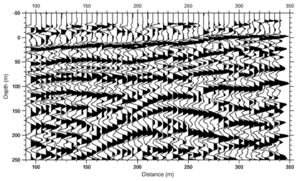SEG-Y
 An image of seismic line that was originally encoded in the SEG-Y format. | |
| Filename extension | .sgy, .segy |
|---|---|
| Developed by | SEG Technical Standards Committee |
| Initial release | 1975 |
| Latest release | rev 2.0 March 2017 |
| Type of format | Reflection seismology data |
| Extended from | SEG "Ex" |
The SEG-Y (sometimes SEG Y) file format is one of several standards developed by the Society of Exploration Geophysicists (SEG) for storing geophysical data. It is an open standard, and is controlled by the SEG Technical Standards Committee, a non-profit organization.
History
The format was originally developed in 1973 to store single-line seismic reflection digital data on magnetic tapes. The specification was published in 1975.[1]
The format and its name evolved from the SEG "Ex" or Exchange Tape Format.[1][2] However, since its release, there have been significant advancements in geophysical data acquisition, such as 3-dimensional seismic techniques and high speed, high capacity recording.
The most recent revision of the SEG-Y format was published in 2017, named the rev 2.0 specification.[3] It still features certain legacies of the original format (referred as rev 0), such as an optional SEG-Y tape label, the main 3200 byte textual EBCDIC character encoded tape header and a 400 byte binary header.
Data structure
This image shows the byte stream structure of a SEG-Y file, with rev 1 Extended Textual File Header records.
Many SEG-Y programs do not totally follow the specification. For example, ODEC uses the opposite byte order and adds 320 bytes to the tail of each trace.[4]
Since the first SEG-Y standard was published, many companies dealing with seismic data have produced variants of the SEG-Y standard which have run contrary to the aims of defining a standard for universal interchange, thus generally causing confusion and delay when data received by a company in expected SEG-Y format turns out to be a variant of that format. Initially, many of these derived from the fact that the format was based on the de-facto standard of using IBM computers for digital processing where character data was coded in EBCDIC and number data in IBM Floating Point, whereas processing systems in use quickly evolved based on ASCII character and IEEE number representations.
Even before the SEG-Y standard was agreed and published, earlier seismic data format standards published by the SEG such as SEG-A, SEG-B and SEG-C were modified by seismic acquisition companies, though not to the wide extent that the SEG-Y format has been modified by seismic acquisition and processing companies and oil companies using their own inhouse software.
PASSCAL SEG-Y format
A related format called "PASSCAL SEG-Y" is sometimes used to store continuous seismic records longer than a typical shot gather and should not be confused with the shot-gather focused "SEG-Y" format documented above.[5] PASSCAL SEG-Y files contain a single trace, and therefore consist of solely a 240-byte trace header and a variable-length stream of binary integers (which can be much longer than the 32767-sample limit in shot-gather SEG-Y files).
See also
References
- ^ a b Barry, K.M.; Cavers, D.A.; Kneale, C.W. (1975). "Recommended standards for digital tape formats" (PDF). Geophysics. 40 (2): 344–352. Bibcode:1975Geop...40..344B. doi:10.1190/1.1440530.
- ^ Northwood, E.J.; Weisinger, R.C.; Bradley, J.J. (1967). "Recommended standards for digital tape formats" (PDF). Geophysics. 32 (6): 1073–1084.
- ^ Hagelund, Rune; Stewart A. Levin, eds. (2017). SEG-Y_r2.0: SEG-Y revision 2.0 Data Exchange format (PDF). Tulsa, OK: Society of Exploration Geophysicists.
- ^ "SIOSEIS DISKIN Documentation". Paul Henkart. Retrieved 2009-02-09.
- ^ "PASSCAL SEG-Y Trace Header". Retrieved 2019-09-17.
- Downloadable SEG Technical Standards, including SEG Y revisions 0, 1 and 2
